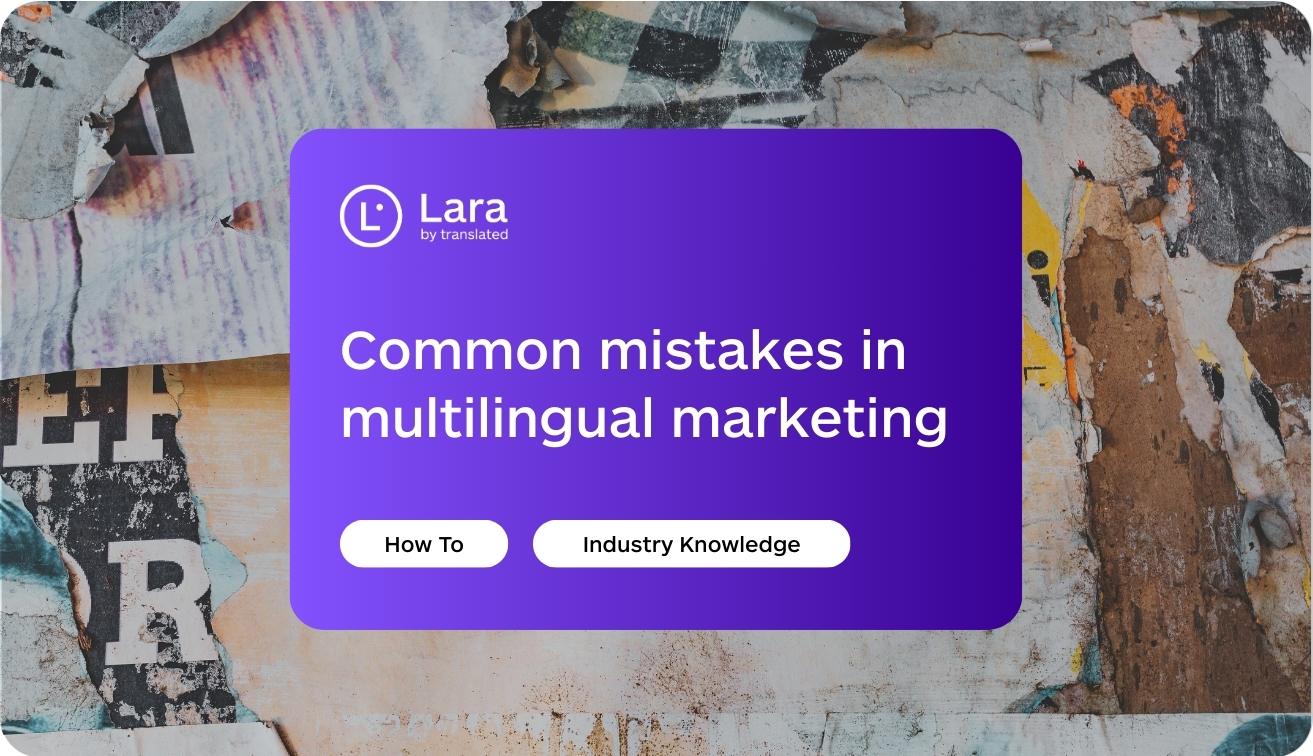When HSBC’s slogan “Assume Nothing” was mistranslated as “Do Nothing,” the bank didn’t just lose meaning — it lost $10 million rebranding its global private banking arm.
It’s a perfect example of multilingual mistakes and of how even the biggest brands can stumble when marketing messages don’t land as intended across cultures.

Expanding globally is exciting but also risky. From tone that doesn’t translate, to phrases that accidentally offend, multilingual marketing mistakes can do real damage to your brand and your bottom line.
Relying exclusively on machine translation
Perhaps the most prevalent of all translation errors in marketing is over-reliance on automated translation tools. While machine translation has improved dramatically, it still struggles with nuance, cultural context, and marketing language that’s often creative, idiomatic, or deliberately ambiguous.
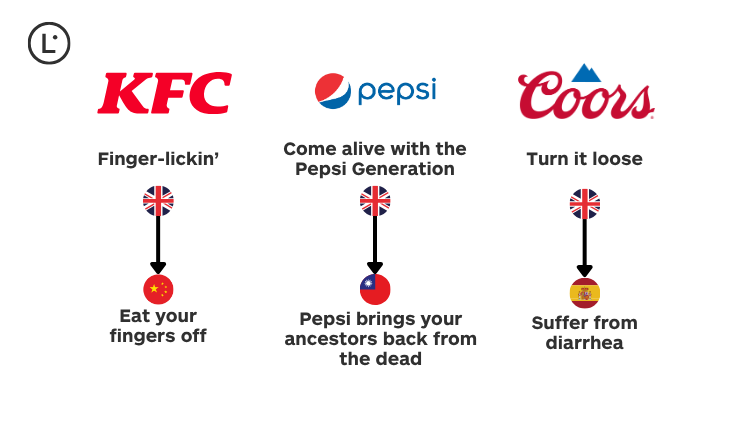
Consider these infamous bad translations in ads examples:
- KFC’s slogan “Finger-lickin’ good” being translated in Chinese as “Eat your fingers off”
- Pepsi’s “Come alive with the Pepsi Generation” becoming “Pepsi brings your ancestors back from the dead” in Taiwan
- Coors’ “Turn it loose” campaign translating to “Suffer from diarrhea” in Spanish
These marketing translation failures happen because machines translate words, not ideas. Marketing copy requires cultural translation that preserves intention rather than literal meaning.
How to avoid this mistake:
- Use machine translation only as a starting point
- Invest in professional human translators with marketing expertise
- Implement a review process with native speakers from your target markets
- Consider transcreation (creative translation) rather than direct translation for slogans and taglines
Lara Translate offers a sophisticated approach that combines the efficiency of AI with human-quality results. Unlike traditional machine translation tools, Lara’s technology understands context and nuance, making it particularly effective for marketing content. The system’s Model Context Protocol (MCP) ensures translations maintain brand voice while adapting appropriately to cultural contexts, helping marketers avoid the pitfalls of purely automated solutions while still working efficiently.
Ignoring cultural nuances and sensitivities
Another major category of marketing localization pitfalls involves overlooking the cultural context of your target markets. Cultural values, taboos, humor, and symbolism vary widely across regions, and what works in one culture may be confusing or offensive in another.
Colors, numbers, gestures, and imagery all carry different associations depending on the culture:
- White symbolizes mourning in many Asian countries but purity in Western cultures
- The number 4 is considered unlucky in China, Japan, and Korea due to its similar pronunciation to “death”
- The thumbs-up gesture is positive in the US but offensive in parts of the Middle East
- Images of certain animals can have negative connotations in specific cultures
Branding in translation requires understanding these cultural frameworks. For example, when Procter & Gamble first marketed Pampers diapers in Japan, they used the standard Western imagery of a stork delivering a baby. The campaign flopped because in Japanese folklore, babies are delivered on giant floating peaches, not by storks.
How to avoid this mistake:
- Conduct thorough cultural research before entering new markets
- Work with local marketing experts who understand cultural nuances
- Test campaigns with focus groups from your target culture
- Develop cultural style guides for each market
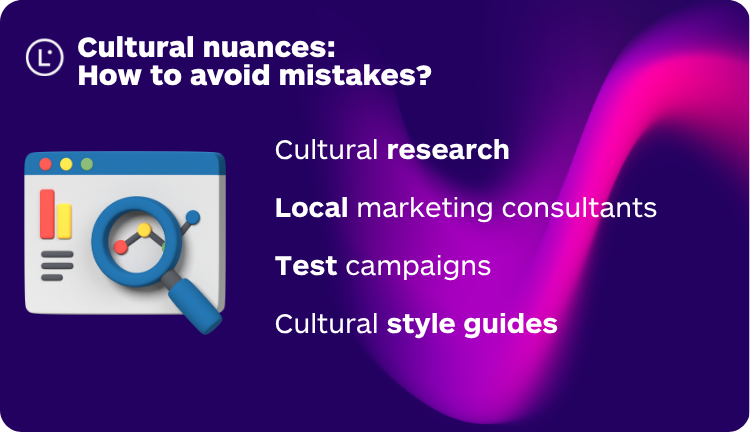
Failing to adapt content for local markets
Simply translating your existing content word-for-word is insufficient for effective global marketing. True localization involves adapting your message for local relevance, preferences, and behaviors.
Multilingual campaign adaptation means reconsidering:
- Reference points and examples
- Celebrity endorsements and influencers
- Holidays and seasonal promotions
- Humor and idioms
- Visual elements and design aesthetics
McDonald’s excels at multilingual marketing by adapting its menu, promotions, and campaigns to local tastes. In India, they offer the McAloo Tikki burger with potato patties instead of beef, while in France, they sell macarons and feature more upscale café-style interiors.
How to avoid this mistake:
- Develop market-specific content strategies rather than simply translating existing materials
- Research local competitors and successful campaigns in your target market
- Understand the digital platforms and channels most relevant in each region
- Adapt your value proposition to address specific local pain points and preferences
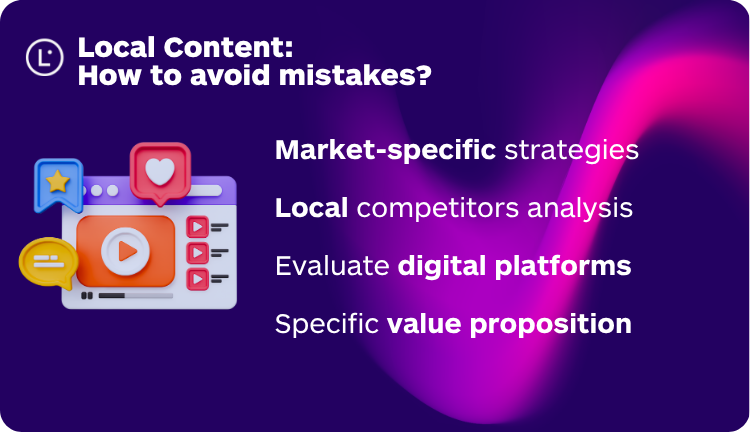
Inconsistent brand voice across languages
Maintaining tone consistency while adapting content for different markets is one of the trickiest multilingual branding challenges. Companies often struggle with how to localize tone of voice without losing their distinctive brand personality.
This challenge intensifies when working with multiple translation vendors or freelancers, each potentially interpreting your brand voice differently. The result is a fragmented brand experience that confuses customers and dilutes brand equity.
How to avoid this mistake:
- Create comprehensive brand guidelines that define your voice, tone, and messaging principles
- Develop multilingual glossaries of approved terminology for key brand concepts
- Establish style guides for each language that maintain brand essence while adapting to local norms
- Implement regular translation quality control reviews to ensure consistency
- Use centralized translation management systems to maintain oversight
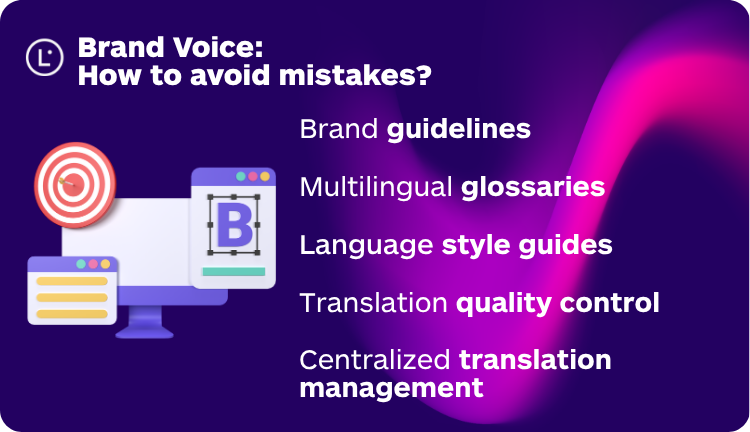
Lara Translate MCP Server helps maintain consistency across languages by storing preferred translations and brand terminology. This technology creates a feedback loop that continuously improves results, ensuring your marketing content maintains a unified voice regardless of language.
Neglecting multilingual SEO strategy
A common oversight in multilingual marketing is failing to develop a comprehensive search strategy for each market. Many businesses simply translate their keywords directly, making huge multilingual mistakes, from their primary market, missing the opportunity to rank for the terms their target audience actually uses.
Search behavior varies significantly across cultures:
- Different keyword preferences and search volumes
- Varying search engines (Baidu in China, Yandex in Russia)
- Different search features and ranking factors
- Local competitors with established SEO presence
How to avoid this mistake:
- Conduct keyword research specifically for each target market
- Implement proper hreflang tags to help search engines serve the correct language version
- Create localized metadata (title tags, meta descriptions, alt text)
- Consider local hosting or CDNs for improved page speed in distant regions
- Build backlinks from local websites and publications
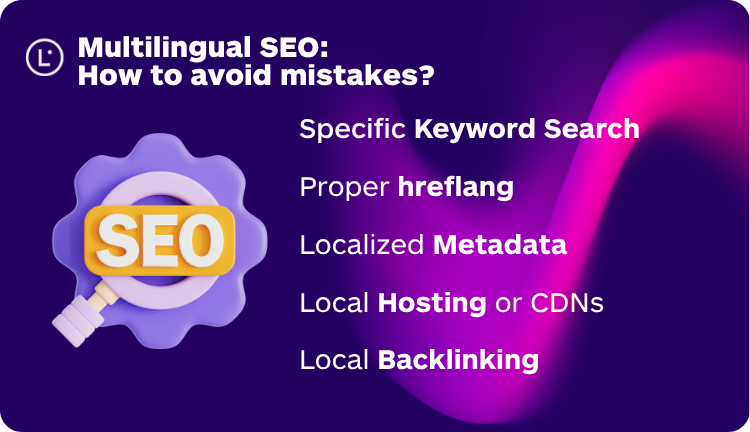
Overlooking local legal and regulatory requirements
Different regions have varying regulations around marketing claims, data privacy, contests, disclosures, and industry-specific advertising. Ignoring these can result in expensive legal problems, campaign shutdowns, or damage to your reputation.
For example, the European Union’s GDPR has strict requirements for data collection and consent that differ from regulations in the United States or Asia. Similarly, health claims that are acceptable in one country may be prohibited in another.
How to avoid this mistake:
- Consult with legal experts familiar with local advertising regulations
- Review all promotional campaigns, contests, and giveaways for compliance with local laws
- Adapt privacy policies and data collection practices to meet local requirements
- Be particularly cautious with regulated industries (healthcare, financial services, etc.)

Best practices: Local marketing do’s and don’ts
To successfully navigate the challenges of multilingual mistakes in marketing, follow these essential guidelines:
Do:
- Do invest in professional translation and localization services
- Do involve local teams in the content creation process
- Do create market-specific content calendars aligned with local events
- Do test campaigns with local focus groups before full launch
- Do regularly audit your localized content for consistency and accuracy
Don’t:
- Don’t assume cultural references will translate across markets
- Don’t launch campaigns simultaneously without considering local context
- Don’t use idioms, puns, or wordplay that won’t translate well
- Don’t rely solely on back-translation to verify accuracy
- Don’t treat localization as an afterthought in your marketing strategy
Building a successful multilingual marketing strategy
Avoiding multilingual marketing mistakes requires a strategic approach from the outset. The most successful global brands integrate localization into their marketing process rather than treating it as a final step.
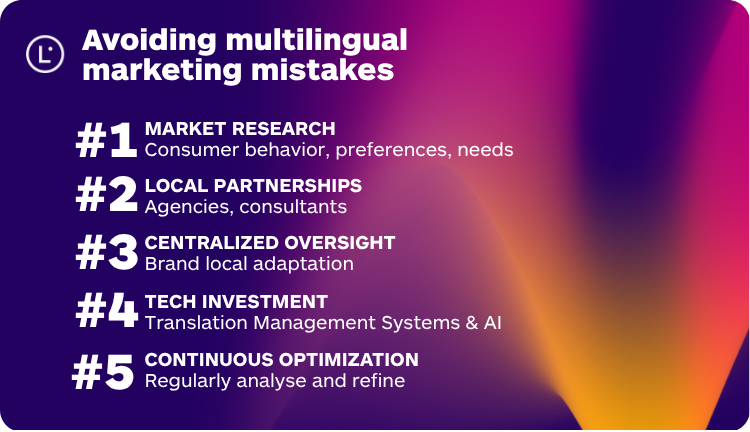
Consider these elements when developing your multilingual strategy:
- Market research: Understand consumer behaviors, preferences, and needs in each target market
- Local partnerships: Collaborate with local agencies or consultants who understand the market nuances
- Centralized oversight: Maintain brand consistency while allowing for local adaptations
- Technology investment: Utilize translation management systems and AI-powered tools
- Continuous optimization: Regularly analyze performance across markets and refine your approach
Lara Translate stands out as a powerful ally in this process, combining advanced AI translation capabilities with an understanding of marketing context. Its technology adapts to your brand voice and learns from feedback, making it particularly valuable for marketing teams managing content across multiple languages.
FAQ: Mastering multilingual marketing
How can I maintain brand consistency across multiple languages?
Develop comprehensive brand guidelines with examples for each market, create terminology glossaries, and implement a centralized review process. Tools like Lara Translate can help maintain tone consistency by learning your preferred translations and brand voice.
What’s the difference between translation and localization?
Translation converts text from one language to another, while localization adapts the entire content experience—including cultural references, imagery, format, and functionality—to feel natural to the local audience. Effective multilingual marketing requires both.
How do I know if my marketing content is culturally appropriate?
Work with native speakers who understand both the language and cultural context of your target market. Conduct focus groups with local consumers and research local competitors’ campaigns. Pay special attention to imagery, colors, numbers, and gestures that may have different meanings across cultures.
Should I create separate websites for each market?
It depends on your resources and goals. Options include using country-specific domains (example.fr), subdomains (fr.example.com), or subdirectories (example.com/fr/). Each has SEO implications, so consult with an international SEO specialist when making this decision.
How can I effectively manage multilingual social media?
Consider creating separate accounts for major markets, posting at times appropriate for local audiences, and using a social media management tool with translation capabilities. Always have native speakers review content before posting, as social media mistakes can spread rapidly.
This article is about:
- Common multilingual marketing mistakes that can harm your global brand reputation
- How to avoid localization pitfalls with strategic planning and proper translation workflows
- Best practices for preserving brand identity while adapting campaigns to local markets
- Tools and processes that ensure translation quality control in global marketing content
Useful links
